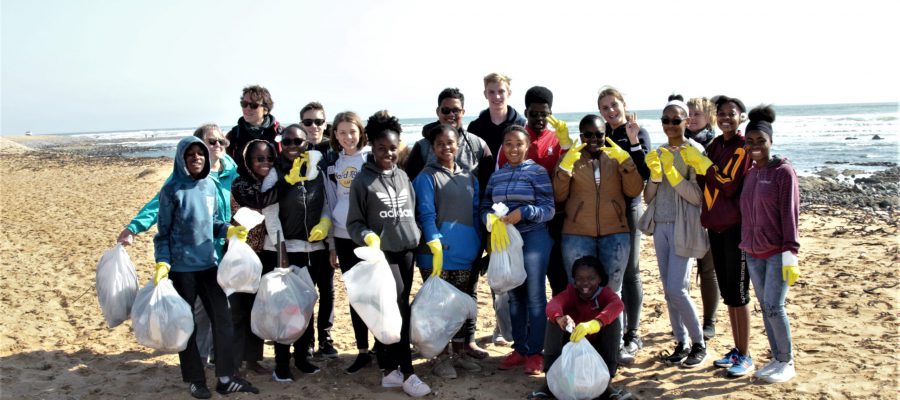A Namibian proverb says, “Trees can’t meet, but humans can.” So the ClimateScouts from Sulingen High School travelled to Namibia for a climate workshop at the Namib High School in Swakopmund from 1 to 11 September. After the long, exhausting journey in a full train and fully occupied airliner, the group got an impression of the vastness of the country on the trip from Windhoek to Swakopmund. The landscape types ranged from the inland to the coast from tree savannah, bush savannah and grass steppe to desert. You could also see the first African animals passing by: Cow antelopes, baboons and strange birds. The colours were unexpected for the students who had never been to Namibia before. Unlike here, where green tones predominate, there are many shades of brown – from light beige to deep dark red on the ground and many blue and grey tones in the sky and water. And what was immediately noticeable: In Namibia, one drives on the left side of the road.
At the meeting with the Namibian ClimateScouts the next day, everyone first introduced themselves and the peculiarities of their country or region – and, what is also important to the Namibians – their ethnic group. But soon they started talking about everything, from plastic garbage to favourite food. In the afternoon there was an interesting city tour for the German group, which dealt with the history of the city and the country. On the next two days, the German ClimateScouts were able to experience everyday school life in Namibia – in classes with almost 50 pupils, without a smartboard, with a blackboard and sometimes just over half an hour for one subject before the next change came. The school day always ends at 13:20. In the afternoon on Wednesday the visit of the aquarium was scheduled, which was also connected with a lecture about the work of the aquarium and the endangerment of the oceans – in English. On Thursday afternoon all ClimateScouts met for a beach cleanup. Some plastic bags were filled with garbage. The work of this afternoon did not go unnoticed. The operator of the Snake Park was very enthusiastic and invited all ClimateScouts to visit the park for free.
Also on Friday, Saturday and Sunday the ClimateScouts were on their way: On a boat tour in Walvis Bay there were seals, pelicans, flamingos, cormorants, Dominican seagulls and jackals to be seen, but also oil platforms, where no oil was found off Namibia. In the afternoon teachers of the NHS invited to mini golf and sandboarding. On Saturday the ClimateScouts learned a lot about the fragile ecosystem of the Namib fog desert and got to know some (small) inhabitants: Geckos, chameleons, a leg loose lizard (Skink) and a dwarf puff adder. On Sunday we finally went to the Mondesa district, where a large part of Swakopmund’s population lives. Mondesa was established as a township in 1961 by the South African apartheid government (today’s Namibia was under South African administration). All blacks had to settle there, whereby the different ethnic groups were assigned differently good dwellings in order to sow envy and discord. The “old” Mondesa is bordered by the Democratic Resettlement Community (DRC), where new arrivals from the country or from other states such as Zimbabwe or Congo live (temporarily or even longer). There is no electricity, but there are water taps where fresh water can be tapped according to a prepaid system, and there are also toilets (but without flushing). The huts, however, are made of boards, cardboard and corrugated iron. “When we saw today how the people in the DRC live – in small and partly self-built huts, we only realized how well we have it at home in Germany”, the ClimateScouts formulated their impression.
Finally, on Monday morning, upcycling was on the agenda. The ClimateScouts created works of art from packaging waste. After an afternoon spent together visiting the Snake Park, it was time to say goodbye. Now everyone is hoping for a reunion and joint projects in Sulingen in 2020. The Sonnenkinderprojekt Namibia, cooperation partner and initiator of the ClimateScout exchange, has already applied for funding.
